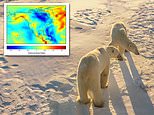
Maybe the real weight loss secret is moving to the tundra?
Surrounding Canada’s Hudson Bay region, far to the northeast, researchers in the 1960s discovered that everything weighed just slightly less,
In an area of upwards of 500,000 square miles, you lose around 1/25,000 of your body weight.
Scientists first discovered this anomaly back in the 1960s, while mapping variations across Earth’s gravitational fields for the first time. But it has taken them decades to understand why.
The cause? Reduced molten magma under the surface of the region, squished out by pressure above-ground from two gigantic glaciers during the last ice age.
This map of Earth’s gravity field, published from work by joint NASA-German Aerospace Center Gravity Recovery and Climate Experiment (GRACE) mission on July 30, 2003, shows in deep blue the unusual gravity anomaly surrounding Canada’s salty northeastern Hudson Bay
Many polar bears make their home around the Hudson Bay’s ice flows and sandy shores. Each bear weighs just slightly less, about 1/25,000 of what their weight would be at a zoo elsewhere
Say you weighed 150 lbs. Near Hudson Bay, the scale would read about 149.994 lb.
The simple answer to this mystery begins with the fact the gravitational pull any object exerts on another is directly proportional to its mass.
But, since an object entering into Hudson Bay isn’t necessarily shedding any mass on the way in, that doesn’t explain the mystery of Canada’s ‘missing’ gravity.
To solve that, researchers turned to NASA’s twin Gravity Recovery and Climate Experiment (GRACE) satellites, which they used to map two gravity anomalies surrounding Canada’s large saltwater bay in 2007 and how those anomalies are changing over time.
‘The Canadian anomaly has been known for a long time and is the result of crustal deformation during the last ice age,’ physicist Dan Britt, director of the Center for Lunar and Asteroid Surface Science at the University of Central Florida, told the DailyMail.com via email.
Back then, around 20,000 years ago, Canada and much of North America lay in cold storage underneath the Laurentide Ice Sheet, an expansive glacier about two miles thick in the regions near Hudson Bay.
‘A couple of miles of ice is heavy enough to depress the crust,’ said Britt, whose own work has, on occasion, involved fine-tuning lunar gravitational models based on the geological differences between different types of moon rocks.
‘The same process is playing out in various places that have had thick ice sheets,’ Britt said.
‘The details have to do with the viscosity of the mantle.’
Under the crushing weight of the Laurentide Ice Sheet, Earth’s crust around Hudson Bay began to compress and sink.
In the process, it shifted away some of the hot magma in the semifluid mantle layer beneath it, like a squished sandwich pushing away peanut butter and jelly.
This compression was most severe on either side of Hudson Bay, where two gigantic domes had formed on the ice sheet.
The gradual recession of the Laurentide over the next 10,000 years was responsible for many North American landmarks, including the Great Lakes.
Some theorists predicted that all that displaced molten mass had reduced Earth’s gravitational pull around Hudson Bay—but NASA’s GRACE satellites showed that was only part of the story.
While the Laurentide Ice Sheet theory and data from GRACE account for some of the reasons there is missing gravity over Canada, they only explain roughly 25-45 percent of the gravitational difference.
Scientists estimate that the remaining 55-75 percent is down to a theory to do with convention.
Way below the Earth’s surface, a sheet of molten rock, known as magma, produces convection currents because of the natural rising and falling of the bubbling substance.
This drags the Earth’s continental plates inwards, which causes a drop in the mass and gravity of the Hudson Bay area.
The gravity is forecast to return to Canada, but gradually.
Geophysicist Mark Tamisiea of the Harvard-Smithsonian Center for Astrophysics in Cambridge, Massachusetts told the journal Science that that it will take up to 300,000 years for the regions’ gravity to even out to the global average.
Source link
CHECK OUT: Top Travel Destinations
READ MORE: Travel News



